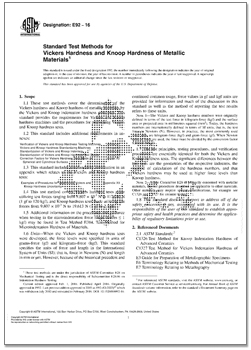英文名稱:
ASTM E92-16
Standard Test Methods for Vickers Hardness and Knoop Hardness of Metallic Materials
中文名稱:
ASTM E92-16
金屬材料維氏及努氏硬度標準試驗方法
代號說明:
This standard is issued under the fixed designation E92; the number immediately following the designation indicates the year of original
adoption or, in the case of revision, the year of last revision.Anumber in parentheses indicates the year of last reapproval.Asuperscript
epsilon (ε) indicates an editorial change since the last revision or reapproval.
This standard has been approved for use by agencies of the U.S. Department of Defense.
版本說明:
1 These test methods are under the jurisdiction of ASTM Committee E28 on Mechanical Testing and is the direct responsibility of Subcommittee E28.06 on Indentation Hardness Testing.
Current edition approved Feb. 1, 2016. Published April 2016. Originally approved in 1952. Last previous edition approved in 2003 as E92–82(2003) which was withdrawn July 2010 and reinstated in February 2016. DOI: 10.1520/E0092-16.
2 For referenced ASTM standards, visit the ASTM website, www.astm.org, or contact ASTM Customer Service at service@astm.org. For Annual Book of ASTM Standards volume information, refer to the standard’s Document Summary page on the ASTM website.
標準正文:
1. Scope
1.1 These test methods cover the determination of the Vickers hardness and Knoop hardness of metallic materials by the Vickers and Knoop indentation hardness principles. This standard provides the requirements for Vickers and Knoop hardness machines and the procedures for performing Vickers and Knoop hardness tests.
1.2 This standard includes additional requirements in annexes:
Verification of Vickers and Knoop Hardness Testing Machines Annex A1
Vickers and Knoop Hardness Standardizing Machines Annex A2
Standardization of Vickers and Knoop Indenters Annex A3
Standardization of Vickers and Knoop Hardness Test Blocks Annex A4
Correction Factors for Vickers Hardness Tests Made on Spherical and Cylindrical Surfaces Annex A5
1.3 This standard includes nonmandatory information in an appendix which relates to the Vickers and Knoop hardness tests:
Examples of Procedures for Determining Vickers and Knoop Hardness Uncertainty Appendix X1
1.4 This test method covers Vickers hardness tests made utilizing test forces ranging from 9.807 × 10 -3 N to 1176.80 N (1 gf to 120 kgf), and Knoop hardness tests made utilizing test forces from 9.807 × 10 -3 N to 19.613 N (1 gf to 2 kgf).
1.5 Additional information on the procedures and guidance when testing in the microindentation force range (forces ≤ 1kgf) may be found in Test Method E384, Test Method for Microindentation Hardness of Materials.
1.6 Units—When the Vickers and Knoop hardness tests were developed, the force levels were specified in units of grams-force (gf) and kilograms-force (kgf). This standard specifies the units of force and length in the International System of Units (SI); that is, force in Newtons (N) and length in mm or μm. However, because of the historical precedent and continued common usage, force values in gf and kgf units are provided for information and much of the discussion in this standard as well as the method of reporting the test results refers to these units.
NOTE 1—The Vickers and Knoop hardness numbers were originally defined in terms of the test force in kilogram-force (kgf) and the surface area or projected area in millimetres squared (mm 2 ). Today, the hardness numbers are internationally defined in terms of SI units, that is, the test force in Newtons (N). However, in practice, the most commonly used force units are kilogram-force (kgf) and gram-force (gf). When Newton units of force are used, the force must be divided by the conversion factor 9.80665 N/kgf.
1.7 The test principles, testing procedures, and verification procedures are essentially identical for both the Vickers and Knoop hardness tests. The significant differences between the two tests are the geometries of the respective indenters, the method of calculation of the hardness numbers, and that
Vickers hardness may be used at higher force levels than Knoop hardness.
NOTE 2—While Committee E28 is primarily concerned with metallic materials, the test procedures described are applicable to other materials. Other materials may require special considerations, for example see C1326 and C1327 for ceramic testing.
1.8 This standard does not purport to address all of the safety concerns, if any, associated with its use. It is the responsibility of the user of this standard to establish appropriate safety and health practices and determine the applicability of regulatory limitations prior to use.
2. Referenced Documents
2.1 ASTM Standards:
C1326 Test Method for Knoop Indentation Hardness of Advanced Ceramics
C1327 Test Method for Vickers Indentation Hardness of Advanced Ceramics
E3 Guide for Preparation of Metallographic Specimens
E6 Terminology Relating to Methods of Mechanical Testing
E7 Terminology Relating to Metallography
E29 Practice for Using Significant Digits in Test Data to Determine Conformance with Specifications
E74 Practice of Calibration of Force-Measuring Instruments for Verifying the Force Indication of Testing Machines
E140 Hardness Conversion Tables for Metals Relationship Among Brinell Hardness, Vickers Hardness, Rockwell Hardness, Superficial Hardness, Knoop Hardness, Scleroscope Hardness, and Leeb Hardness
E175 Terminology of Microscopy
E177 Practice for Use of the Terms Precision and Bias in ASTM Test Methods
E384 Test Method for Knoop and Vickers Hardness of Materials
E691 Practice for Conducting an Interlaboratory Study to Determine the Precision of a Test Method
2.2 ISO Standards:
ISO 6507-1 Metallic Materials—Vickers hardness Test—Part 1: Test Method
ISO/IEC 17011 Conformity Assessment—General Requirements for Accreditation Bodies Accrediting Conformity Assessment Bodies
ISO/IEC 17025 General Requirements for the Competence of Testing and Calibration Laboratories
在線閱讀 免費下載







